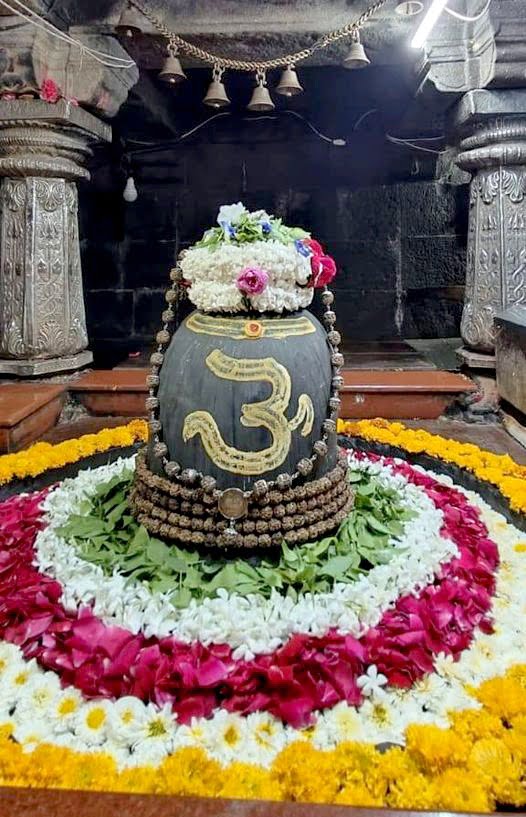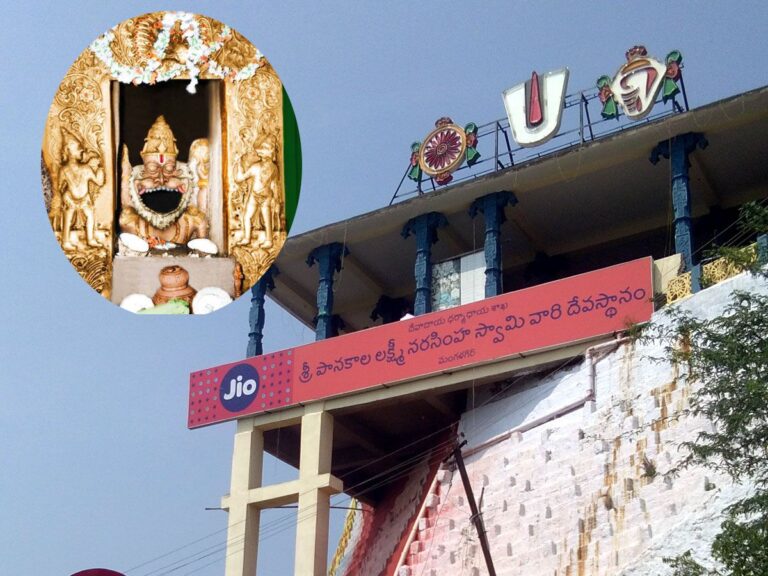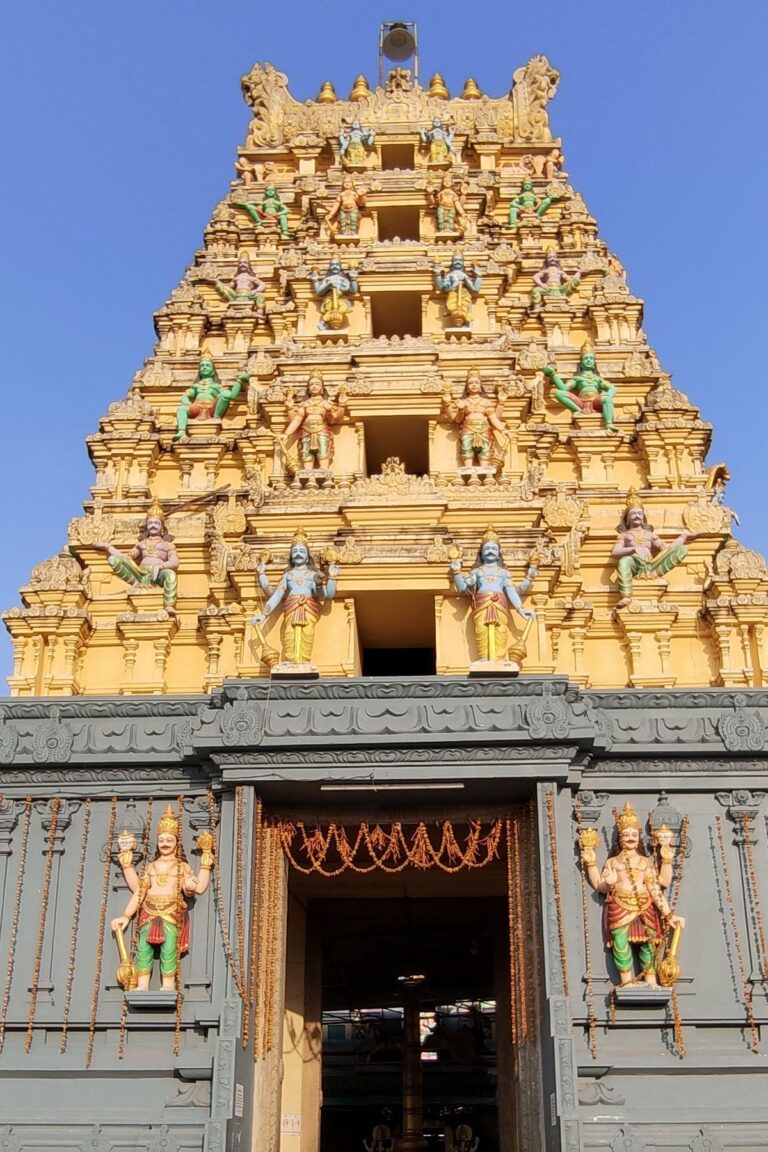Simhachalam Temple – Varaha Lakshmi Narasimha Swamy
The Simhachalam Temple, also known as Varaha Lakshmi Narasimha Temple, is a Hindu temple situated on the Simhachalam Hill Range, which is 300 meters above sea level in the city of Visakhapatnam, Andhra Pradesh, India. It is dedicated to Lord Vishnu, who is worshipped there as Varaha Narasimha, a half-man, half-lion incarnation of Vishnu.
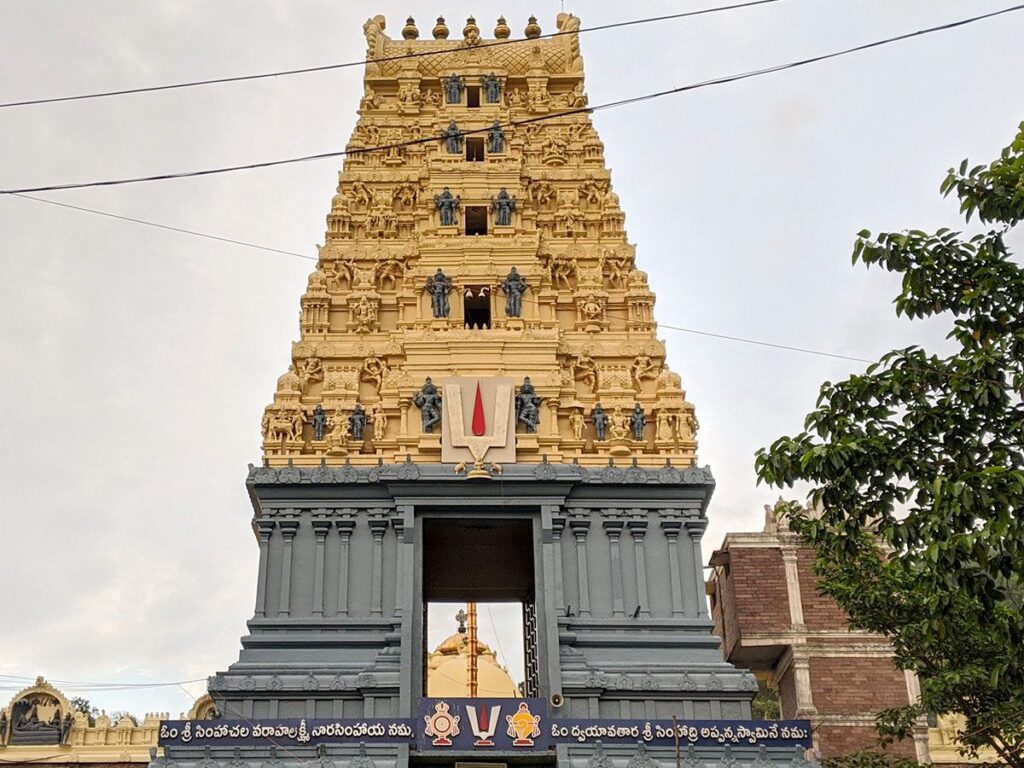
Contents
- 1 Simhachalam Temple History:
- 2 Legend of Simhachalam Temple:
- 3 Significance of Simhachalam Temple:
- 4 Myths and Beliefs of Simhachalam Temple:
- 5 Simhachalam Temple Architecture:
- 5.0.1 Nageshwar Jyotirlinga Dwaraka: 7th CE Temple with Divine Powers
- 5.0.2 Grishneshwar Temple: Wealth and Pleasure at Shiva’s Feet
- 5.0.3 Kedarnath Temple: One of Jyotirling & Char Dham
- 5.0.4 Trimbakeshwar Jyotirlinga Temple
- 5.0.5 Sacred Kashi Vishwanath Temple: 11th Jyotirling of Liberation
- 5.0.6 Aundha Nagnath Temple: 8th Jyothirling with Divine Serpents
- 6 Simhachalam Temple Timing and Rituals:
- 6.0.1 Rituals at Simhachalam Temple:
- 6.0.2 Simhachalam Devasthanam official website:
- 6.0.3 Mangalagiri Panakala Narasimha Swamy Temple
- 6.0.4 Vontimitta Temple of Sri Kodanda Rama Swamy
- 6.0.5 Arasavalli Temple | Sri Suryanarayana Swamy Temple
- 6.0.6 Powerful Annavaram Temple Sri Veera Venkata Satyanarayana Swamy
- 6.0.7 Antarvedi Lakshmi Narasimha Swamy Temple
- 6.0.8 Kapila Theertham Temple Tirupati
- 7 Places to visit near Simhachalam Temple:
- 8 FAQ:
- 9 How to reach Simhachalam Temple:
Simhachalam Temple History:
ఉగ్రం వీరం మహావిష్ణుం
జ్వలంతం సర్వతోముఖం
నృసింహం భీషణం భద్రం
మృత్యుమృత్యుం నమామ్యహం
Very Powerful Nrusimha Mantra: Each name in it expresses the philosophy of Nrisimha.
Early Mentions and Origins:
- Historical evidence suggests the temple’s presence as early as the 11th century.
- An inscription dated 1098 AD, attributed to the Chola king Kulottunga I, is the earliest record.
Legends and Local Lore:
- A popular legend attributes the temple’s discovery to a shepherd boy encountering the deity’s form on the Simhachalam hills.
Royal Patronage and Architectural Evolution:
- The temple underwent significant development under various dynasties.
- The Eastern Ganga dynasty, particularly Narasimha Deva I in the 13th century, is credited with building the present structure.
- Inscriptions from the Cholas, Gangas, and the Vijayanagara empire reveal their patronage and contributions.
Unique Features:
- The temple stands as a testament to Kalinga architecture, distinct in the region.
- The main deity, Varaha Narasimha, a fierce form of Lord Vishnu, is a unique representation.
- Interestingly, the deity remains covered in sandalwood paste for most of the year, except on Akshaya Tritiya, when devotees can witness the form.
Read More>> Tirumala Tirupati Venkateswara Swamy
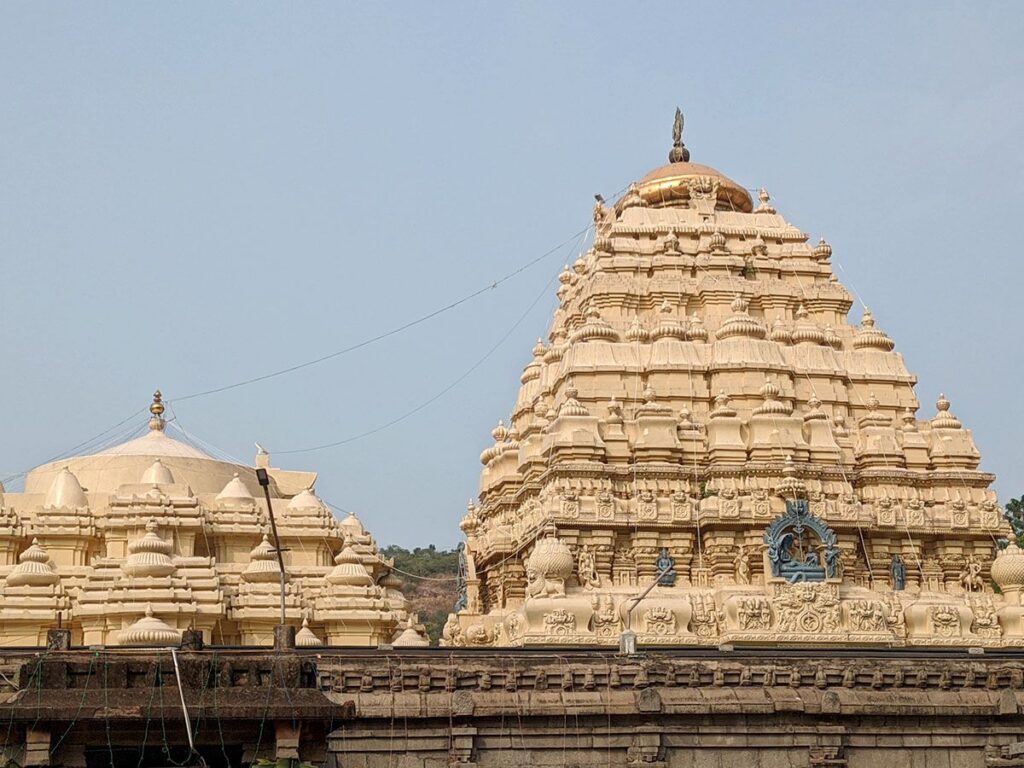
Legend of Simhachalam Temple:
Prahlada’s Devotion: Prahlada, the son of the demon king Hiranyakashipu, was a staunch devotee of Lord Vishnu. This enraged Hiranyakashipu, who believed himself to be the ultimate god.
Trials and Tribulations: Hiranyakashipu subjected Prahlada to numerous attempts to kill him or break his devotion, all in vain.
Narasimha Emerges: When none of Hiranyakashipu’s plans worked, he challenged Vishnu to appear. In response, Vishnu manifested in the form of Narasimha – a half-lion, half-man form.
Narasimha Slays Hiranyakashipu: Narasimha ripped through a pillar Hiranyakashipu declared invincible and killed him on the threshold – a place neither inside nor outside, fulfilling a boon granted earlier.
Varaha Narasimha Form: Prahlada, witnessing Narasimha’s rage, prayed for it to subside. Vishnu, pleased by Prahlada’s unwavering devotion, took the form of Varaha Narasimha, where elements of both his Varaha (boar) and Narasimha avatars were combined.
The Temple’s Birth: Prahlada, overwhelmed with gratitude, built a temple on Simhachalam hill to house this unique form of Lord Vishnu. The name Simhachalam itself translates to “lion hill,” referencing Narasimha’s lion-like features.
Read More>> Chilkur Balaji Temple (Visa Balaji): Where Wishes Come True
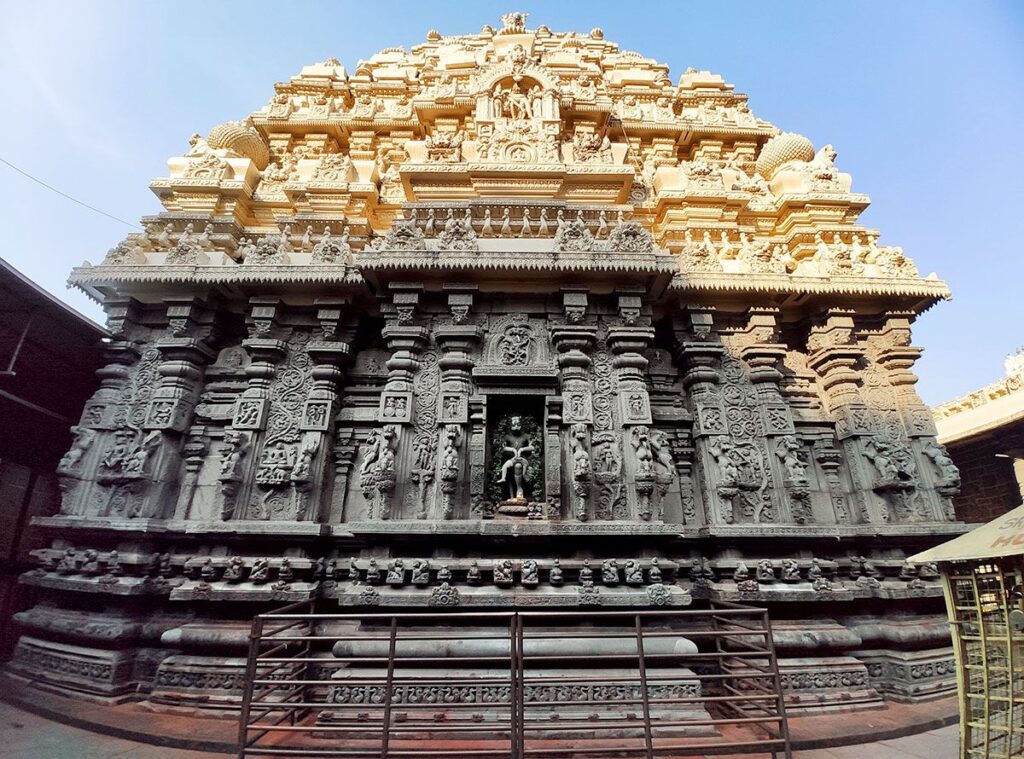
Significance of Simhachalam Temple:
· Religious Significance:
- Dedicated to Varaha Narasimha, a powerful form of Lord Vishnu, it’s one of the 18 important Narasimha Kshetras in India.
- This makes it a major pilgrimage site for Vaishnavites, followers of Vishnu.
- The unique idol, a combined form of Varaha and Narasimha, adds to its religious importance.
· Historical Significance:
- Inscriptions dating back to the 11th century point to its long history.
- The temple reflects the patronage of various dynasties like the Cholas, Gangas, and Vijayanagara empire, showcasing the evolution of the region.
- It stands as a testament to Kalinga architecture, offering a glimpse into the art and styles of the past.
· Cultural Significance:
- The temple is a vital part of Andhra Pradesh’s cultural heritage.
- It attracts pilgrims and tourists from across the country, fostering cultural exchange and traditions.
- The festivals celebrated here, especially the chariot festival, are vibrant expressions of local culture.
· Socio-economic Significance:
- As the second-largest temple in Andhra Pradesh (by income), Simhachalam contributes significantly to the local economy.
- It provides employment and supports related businesses like eateries and souvenir shops.
Read More>> 10th CE Chakrapani Temple Kumbakonam

Myths and Beliefs of Simhachalam Temple:
The Shepherd Boy Discovery: A popular legend tells the story of a shepherd boy who stumbled upon the divine form of Varaha Lakshmi Narasimha while grazing his sheep on the Simhachalam hills. This chance encounter is believed to be how the temple’s location was revealed.
Varaha Narasimha’s Manifestation: The temple enshrines Varaha Narasimha, a fierce avatar of Lord Vishnu with a lion head and a human body. Mythology associates this form with Vishnu’s act of rescuing goddess Bhudevi (Earth) from the clutches of the demon Hiranyakashipu. The Simhachalam temple’s specific depiction of Varaha Narasimha with Lakshmi by his side is considered unique.
Sandalwood Paste and the Annual Revelation: The main idol of Varaha Lakshmi Narasimha remains covered in sandalwood paste throughout most of the year. This practice is believed to have originated to protect the underlying form, which is said to be extremely radiant and could potentially harm devotees if viewed directly. However, on the auspicious occasion of Akshaya Tritiya, a major festival, the sandalwood paste is removed, allowing devotees a rare glimpse of the deity.
Simhachalam, the Lion’s Abode: The name “Simhachalam” translates to “Lion Hill.” Local lore suggests that the Simhachalam hills were once home to lions, further connecting the place to the idea of Narasimha, the lion-headed avatar.
Abode of Healing: Devotees believe that offering prayers at the Simhachalam temple brings blessings, particularly for those seeking good health and overcoming chronic illnesses.
Read More>> Dwaraka Tirumala Temple: Sacred 11th Century Chinna Tirupati
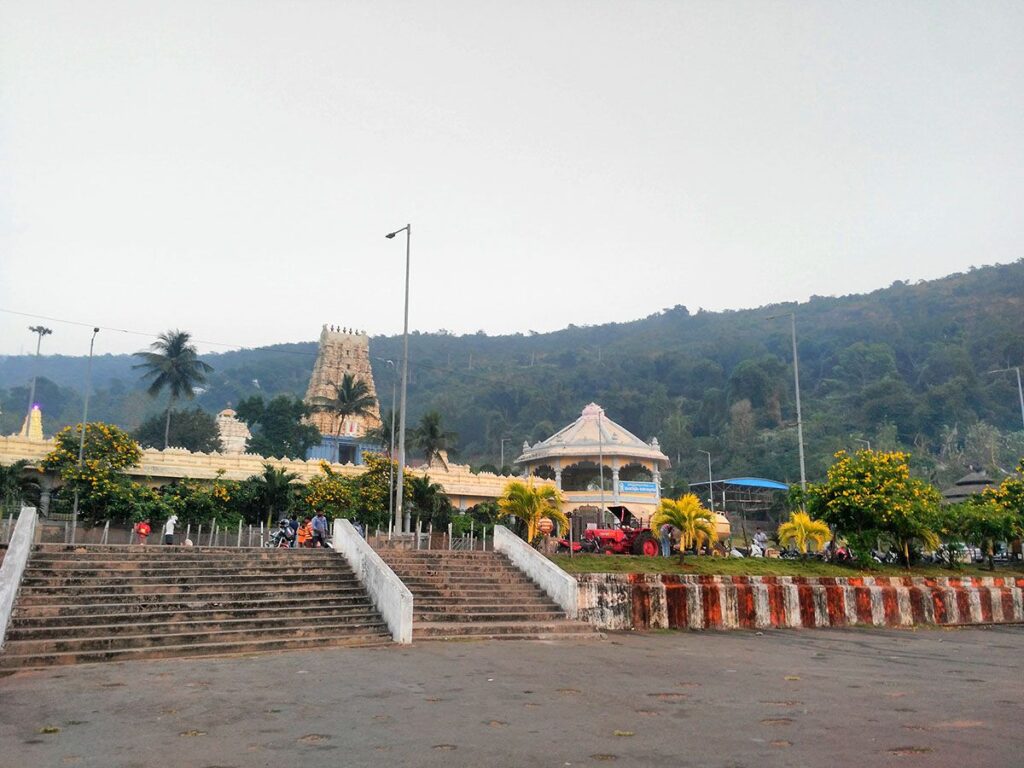
Simhachalam Temple Architecture:
- Gopurams (Entrance Towers):
- The temple is adorned with several intricately carved gopurams (entrance towers) at its entrances, typical of South Indian temple architecture. These towers are adorned with sculptures of deities, celestial beings, and mythological figures.
- Mandapams (Pillared Halls):
- Inside the temple complex, you’ll find numerous mandapams or pillared halls. These halls are adorned with exquisite sculptures depicting various scenes from Hindu mythology and epics like the Ramayana and Mahabharata.
- Main Sanctum:
- The main sanctum of the temple houses the deity of Lord Varaha Narasimha, the presiding deity of Simhachalam. The sanctum is built in the traditional architectural style, with a vimana (tower) rising above it.
- Kalyana Mandapam:
- One of the highlights of the temple is the Kalyana Mandapam, a hall where the celestial wedding of Lord Varaha Narasimha and Goddess Lakshmi is celebrated annually. This mandapam is adorned with exquisite carvings and sculptures.
- Stone Carvings:
- The temple is adorned with intricate stone carvings depicting various forms of Vishnu, scenes from Hindu mythology, and celestial beings. The craftsmanship displayed in these carvings is truly awe-inspiring.
- Prakarams (Enclosures):
- Surrounding the main sanctum, there are several prakarams or enclosures where devotees can circumambulate the temple. These prakarams are lined with smaller shrines dedicated to various deities.
- Dravidian and Kalinga Influence:
- The architecture of Simhachalam Temple reflects a blend of Dravidian and Kalinga styles, owing to its location in the coastal region of Andhra Pradesh. This fusion of styles adds to the unique charm of the temple.
Simhachalam Temple Timing and Rituals:
General Darshan: This is the free public viewing of the deity. Timings typically vary slightly depending on the source, but they are usually around:
- Morning: 7:00 AM to 4:00 PM
- Evening: 6:00 PM to 9:00 PM
Rituals at Simhachalam Temple:
Abhishekam: This is a sacred bath ceremony performed on the idol using various elements like milk, curd, honey, and panchamrita (a five-ingredient nectar). The timing of this can vary depending on the specific abhishekam.
Arati: This is a waving of lamps or camphor before the deity, signifying offering of light and respect. Arati is likely performed at various times throughout the day.
Sevas (Services): These are specific pujas dedicated to the deity with different names and purposes. Some examples might include Nitya Harati (daily offering of lamps) or Rajabhoga (offering food considered fit for a king).
Special Pujas: There are special pujas on various days and festivals throughout the year. Chandanotsavam, celebrated on Akshaya Tritiya, is a particularly significant one where the sandalwood paste is removed from the idol for a limited time.
Simhachalam Devasthanam official website:
For more details on online booking and pooja seva please visit official website: http://simhachalamdevasthanam.net/home.html
Places to visit near Simhachalam Temple:
- Visakhapatnam Beach: Just a short drive away from Simhachalam Temple, Visakhapatnam Beach offers a serene escape with its golden sands and calm waters. Perfect for a relaxing stroll or some beachside fun.
- Kailasagiri: This picturesque hill station is located around 18 kilometers from Simhachalam Temple. It offers stunning panoramic views of the city and the Bay of Bengal. You can enjoy activities like ropeway rides, trekking, and picnics amidst lush greenery.
- Rishikonda Beach: Another beautiful beach near Simhachalam Temple, Rishikonda Beach is known for its pristine shores and water sports activities like jet skiing and windsurfing. It’s a great spot to unwind and soak in the coastal beauty.
- Dolphin’s Nose: For those who love a bit of adventure, Dolphin’s Nose is a rocky promontory located about 357 meters above sea level. It offers breathtaking views of the surrounding landscape and the Bay of Bengal.
- Araku Valley: If you’re up for a longer trip, Araku Valley is worth visiting. Located around 114 kilometers from Simhachalam Temple, this hill station is known for its lush coffee plantations, waterfalls, and tribal culture. Take a scenic train ride on the Araku Valley Railway for a memorable experience.
FAQ:
- What is Simhachalam Temple?
- Simhachalam Temple is a famous Hindu temple dedicated to Lord Varaha Narasimha, an incarnation of Lord Vishnu. It is located atop the Simhachalam Hill in Visakhapatnam, Andhra Pradesh, India.
- What is the significance of Simhachalam Temple?
- The temple is renowned for its deity, Lord Varaha Narasimha, who is believed to fulfill the wishes of his devotees. It is also known for its stunning architecture, especially the intricately carved stone mandapams and gopurams.
- How do I reach Simhachalam Temple?
- Simhachalam Temple is easily accessible by road from Visakhapatnam city. It’s about 16 kilometers away, and you can reach there by private vehicles, taxis, or buses. There’s also a staircase leading up the hill for those who prefer to climb.
- What are the temple timings?
- The temple is usually open from early morning to late evening. Specific timings may vary depending on the day and any special events or rituals. It’s a good idea to check the current timings before planning your visit.
- Are there any dress code requirements?
- While there’s no strict dress code, it’s advisable to dress modestly and respectfully when visiting the temple. Avoid wearing revealing or inappropriate clothing out of respect for the religious sentiments of the devotees.
- Can non-Hindus visit Simhachalam Temple?
- Yes, non-Hindus are allowed to visit Simhachalam Temple and experience its spiritual ambiance. However, all visitors are expected to adhere to the temple’s rules and regulations and show reverence to the deity and the place of worship.
- Are there any nearby attractions to visit along with Simhachalam Temple?
- Yes, there are several nearby attractions like Visakhapatnam Beach, Kailasagiri Hill, Rishikonda Beach, and Araku Valley, which you can explore during your visit to Simhachalam Temple.
How to reach Simhachalam Temple:
- By Air: The nearest airport to Simhachalam Temple is Visakhapatnam Airport (also known as Vizag Airport). From the airport, you can hire a taxi or use app-based cab services to reach the temple. The airport is well-connected to major cities across India.
- By Train: Visakhapatnam Junction is the nearest railway station to Simhachalam Temple. It is a major railway station and is well-connected to various cities in India. From Visakhapatnam Junction, you can hire a taxi or take a local bus to reach the temple, which is about 14 kilometers away.
- By Road: Simhachalam Temple is easily accessible by road. You can reach Visakhapatnam by road from nearby cities like Vijayawada, Hyderabad, and Bhubaneswar. From Visakhapatnam, you can hire a taxi or take a local bus to reach the temple. The temple is located around 14 kilometers from the city center.






